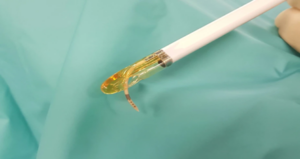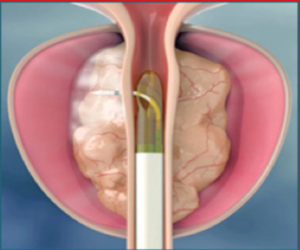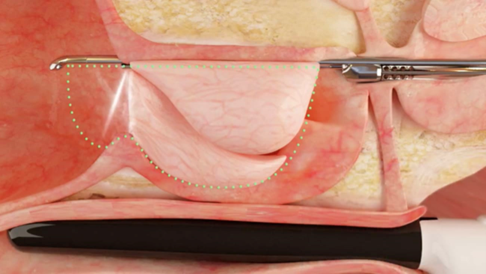Benign Prostatic Hypertrophy - New Surgical Therapies Rezum and Aquablation
In Western countries, the incidence of Benign Prostatic Hyperplasia (BPH) among men aged 50 to 60 is approximately 50%, increasing to 70–80% in those over 70.
BPH symptoms are commonly classified into:
OBSTRUCTIVE SYMPTOMS
- Difficulty starting urination: Needing to “push” to initiate urine flow.
- Weak or intermittent urinary flow: The urine stream is less forceful and irregular.
- Incomplete bladder emptying: A sensation of not fully emptying the bladder.
- Terminal dribbling: Persistent drops of urine at the end of urination.
- Straining during urination: The need to contract abdominal muscles to urinate.
IRRITATIVE SYMPTOMS
- Increased urinary frequency: Needing to urinate more often, especially during the day (pollakiuria).
- Frequent nighttime urination (nocturia): Waking up multiple times at night to urinate.
- Urinary urgency: A sudden, strong need to urinate, with difficulty holding it, sometimes leading to leakage.
- Urgency incontinence (less common): Involuntary loss of urine.
In advanced stages of the disease, complications such as bladder stones (potentially causing bleeding), recurrent urinary infections, or acute urinary retention requiring catheterization may occur.
The factors influencing BPH include age, geographic region (higher prevalence in Western countries, possibly due to diet and stress), genetic predisposition, and hormonal imbalances such as an altered ratio between testosterone and dihydrotestosterone.
However, not all men with BPH develop clinical symptoms. Approximately 30% of men over 50 experience moderate or severe symptoms related to BPH.
While pharmacological treatments (alpha-blockers and 5-alpha-reductase inhibitors) are sufficient in many cases, about 10–30% of patients will require surgical intervention during their lifetime.
TRADITIONAL SURGICAL TREATMENTS
For the past 40 years, the standard surgical treatment has been TURP (Transurethral Resection of the Prostate). This involves the removal of hypertrophic tissue (benign nodules consisting of muscular, glandular, and supportive tissues) using an electric loop.
Another technique developed in the last decade is laser vaporization of the adenoma. For larger adenomas (over 100 grams), a specific laser (Holmium laser) is used to enucleate the adenoma from the surrounding healthy tissue rather than vaporizing it.
SIDE EFFECTS OF TRADITIONAL TECHNIQUES
Short-term complications:
- Intraoperative and postoperative bleeding, sometimes requiring transfusion.
- Urinary infections.
Long-term complications:
- Retrograde ejaculation (75–90% of cases).
- Erectile dysfunction (5–10% of cases).
- Urethral or prostatic fossa strictures (2–10% of cases).
Temporary or permanent urinary incontinence (1–2% of cases).
Since 2021, my team has adopted two innovative surgical techniques: Rezum (for prostates up to 80 grams) and Aquablation (for prostates over 80 grams). These techniques are as effective as traditional methods but avoid the aforementioned side effects, particularly retrograde ejaculation and erectile dysfunction.
NEW SURGICAL APPROACHES:
REZUM
Rezum is a minimally invasive technique that reduces the volume of the prostate without the need for traditional surgical interventions.
In practice, under local anesthesia, through a small cannula inserted into the urethra, injections of high temperature water vapor (100/105°C) are carried out using a porcelain microneedle inside the adenomas.
The heat causes a necrosis of the hyperplastic cells which are reabsorbed within 2/3 weeks, thus reducing the prostate volume and restoring normal urinary function.

Compared to other prostate surgeries (TURP, LASER, etc.) the technique does not require surgical incisions, is extremely quick (about 10 minutes) and reduces the possibility of complications of any kind to a minimum. It is performed under local anesthesia or under mild sedation (the same used for gastroscopies or colonoscopies).

Hospital stay is also reduced to a minimum and the patient can be discharged the same day or the following morning at the latest.
AQUABLATION
Aquablation is a minimally invasive surgical procedure that we use in prostates with a volume greater than 80 grams.
The technique, performed under the guidance of a robotic system, uses a high pressure water jet (80 Atm) which removes excess prostatic tissue like a scalpel.
It is an innovative technique that combines precision and safety, because with robotic guidance we have the ability to preserve the prostatic tissues responsible for maintaining erection and ejaculation.
Under general or local anesthesia, The procedure is guided by a system called AquaBeam, which combines the use of real-time images (transrectal ultrasound) with a high-speed water jet.
Before starting the operation, the surgeon plans the treatment through a robotic interface to ensure maximum precision. At this point the high pressure jets of sterile water are activated which remove the hyperplastic prostatic tissue.
The water is at room temperature and this protects the nervous structures from any damage. The operation lasts approximately 30 minutes and the patient will be discharged after 48 hours.


